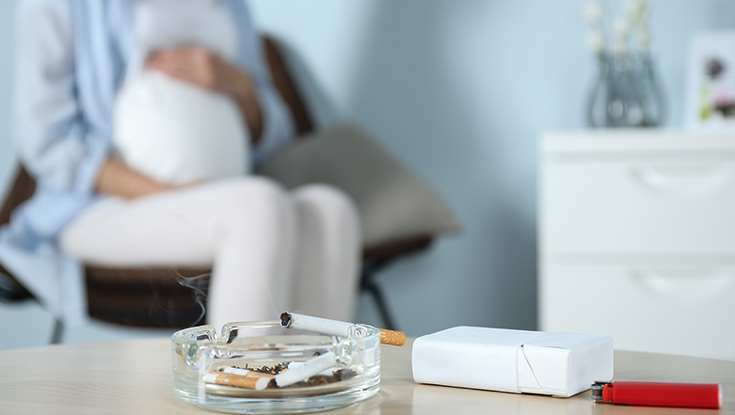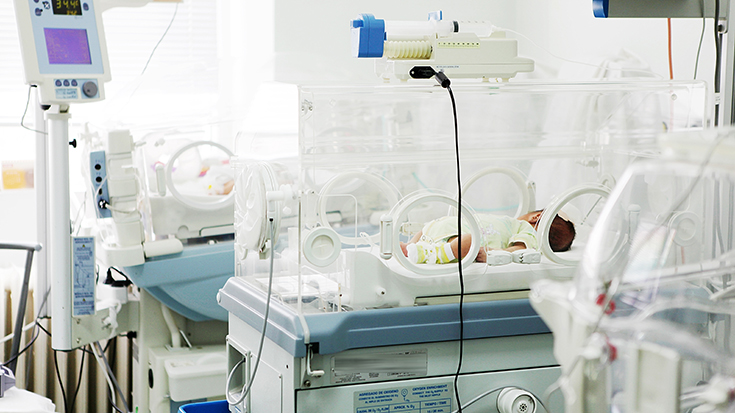
By Mary P. Martinasek, Ph.D, RRT, and Allison Barthel, Student Researcher


Smoking is one of the leading preventable causes of disease and disability in the U.S. One of every five deaths per year has been attributed to cigarette smoking.[1] Additionally, smoking is also one of the most addicting negative health behaviors that transcend life events.
Smoking while pregnant
According to the National Vital Statistics System in 2016, 7.2 percent of pregnant women reported smoking during their pregnancy. In 2014, a report from the Centers for Disease Control (CDC) indicated that 10.9 percent of women smoked within three months of giving birth. [2] Of these women, approximately one quarter of pregnant smokers quit smoking prior to childbirth.
Overall, the prevalence of smoking during pregnancy is highest among women aged 20-24 years and of those who self-described as Non-Hispanic American Indian or Alaska Native. Additionally, the prevalence of smoking was highest in those women who had completed a high school education (12.2 percent). [2] The CDC and specific state data can be found on the Pregnancy Risk Assessment Monitoring System (PRAMS) website. [3]
Health concerns
Maternal smoking has been linked to a host of unfavorable infant, child and maternal health outcomes such as low birth weight, premature delivery, and a greater odds of birth defects; such as gastroschisis (OR 1.5), hernia (OR 1.4), craniosyntosis (OR 1.33), club foot (OR 1.28), and limb reduction defects (OR 1.26).[4]
Health issues can be seen in children whose mothers smoked during pregnancy. Nicotine crosses the placenta and has been found to be concentrated in fetal tissue. Negative effects include speech processing, irritability, and varied attention levels.[5] There are increased risks for obesity, asthma, infectious diseases, and cardiovascular health problems. [6-10]
From a maternal standpoint, there is a direct link between maternal morbidity/placental problems/cancers and smoking. [11] Cigarettes are only one product that delivers nicotine to pregnant mothers and place them at risk.
Maternal use of Swedish Snuff (Snus) has been studied in a large cohort of pregnant women and found to increase the risk of stillbirth (OR 1.6).[12] Despite these risks, women continue to smoke during their pregnancy with one of the main barriers to quitting being the increased nicotine metabolism.[13]
There is no safe level of tobacco use among pregnant women and a direct correlation exists between the number of cigarettes smoked and poor outcomes.[14]
Cessation recommendations
The U.S. Preventative Task Force (USPTF) makes recommendations for smoking cessation.
Regardless of pregnancy status, it is recommended that all clinicians ask about tobacco use, advise them to stop and provide behavioral interventions. [15] Behavioral interventions consist of:
- Behavioral counseling (using motivational interviewing)
- Feedback
- Health education
- Incentives
- Social support
Even brief counseling of three minutes can be billed using CPT codes 99406 and 99407.[16, 17]
Brief intervention for cessation can include the five A’s (Ask, Advise, Assess, Assist, Arrange).
Pharmacotherapy
The USPTF grades pharmacotherapy and electronic nicotine devices (ENDS) as lacking sufficient evidence to ensure the benefits outweigh the harms.[18]
Recent data suggest that pregnant women view ENDS as less harmful than cigarettes and vape as much as they would normally smoke. Education on vape devices and secondhand vapor is important to ensure mothers are not vaping around their children due to the carcinogenic, nicotine and heavy metals found in secondhand vapor. [19, 20]
The World Health Organization (WHO) does not recommend pharmacotherapy, however, encourages clinicians to ask about smoking and secondhand smoke exposure at every encounter.[21] Clinicians should provide expectant mothers with the risks and benefits of pharmacotherapy using a patient-centered approach according to expert pharmacists.
Experts suggest that continued smoking during pregnancy is more harmful than the risks of using pharmacotherapy, however, we lack large datasets to modify current recommendations.[22] Alternative solutions are encouraging pregnant mothers to decrease cigarette consumption use as this improves pregnancy outcomes and decreases developmental issues.
If behavioral interventions and decreasing cigarette consumption are not found to be effective, then expert pharmacist reports that providing decreased amount of alternative forms such as the nicotine replacement therapy (NRT) patch in low does and encouraging no smoking while using the patch may be helpful. Close follow-up for risks of psychiatric disorders is important in these individuals. [22]
For those individuals unwilling to quit the 5 R’s are utilized (Relevance, Risk, Reward, Roadblocks, and Repetition).[23]
Provide education resources
The Baby & Me-Tobacco Free ProgramTM is an evidenced-based program used by many clinicians to help pregnant women stop smoking. The program is set up to provide education and resources for women to quit smoking.
Follow-up visits consist of exhaled carbon monoxide measurements to ensure quit. The positive reinforcement is diaper vouchers that can be used post-partum.[24]
Another evidence-based program is Smoking Cessation and Reduction in Pregnancy TreatmentTM (SCRIPT). This program provides a comprehensive guide for purchase in English and Spanish, as well as video format.[25]
Some states provide quitlines specific for pregnant smokers and other states link pregnant smokers to the regular quitline.[26]
1. 2014 Surgeon General’s Report: The Health Consequences of Smoking—50 Years of Progress. Available at: https://surgeongeneral.gov/library/reports/50-years-of-progress/full-report.pdf
2. Centers for Disease Control and Prevention. Cigarette Smoking During Pregnancy: United States, 2016 2018 [cited 2018 October 30]. Available from: https://cdc.gov/nchs/products/databriefs/db305.htm.
3. Centers for Disease Control and Prevention. What is Prams? 2018. Available from: https://cdc.gov/prams/index.htm.
4. Hackshaw A, Rodeck C, Boniface S. Maternal smoking in pregnancy and birth defects: a systematic review based on 173 687 malformed cases and 11.7 million controls. Human reproduction update. 2011;17(5):589-604.
5. Cornelius MD, Day NL. Developmental consequences of prenatal tobacco exposure. Current opinion in neurology. 2009;22(2):121.
6. Oken E, Levitan E, Gillman M. Maternal smoking during pregnancy and child overweight: systematic review and meta-analysis. International journal of obesity. 2008;32(2):201.
7. Neuman Å, Hohmann C, Orsini N, Pershagen G, Eller E, Kjaer HF, et al. Maternal smoking in pregnancy and asthma in preschool children: a pooled analysis of eight birth cohorts. American journal of respiratory and critical care medicine. 2012;186(10):1037-43.
8. Leybovitz-Haleluya N, Wainstock T, Landau D, Sheiner E. Maternal smoking during pregnancy and the risk of pediatric cardiovascular diseases of the offspring: A population-based cohort study with up to 18-years of follow up. Reproductive Toxicology. 2018;78:69-74.
9. Metzger MJ, Halperin AC, Manhart LE, Hawes SE. Association of maternal smoking during pregnancy with infant hospitalization and mortality due to infectious diseases. The Pediatric infectious disease journal. 2013;32(1):e1.
10. Hu FB, Persky V, Flay BR, Zelli A, Cooksey J, Richardson J. Prevalence of asthma and wheezing in public schoolchildren: association with maternal smoking during pregnancy. Annals of Allergy, Asthma & Immunology. 1997;79(1):80-4.
11. Phelan S. Smoking cessation in pregnancy. Obstetrics and Gynecology Clinics. 2014;41(2):255-66.
12. Wikström A-K, Cnattingius S, Stephansson O. Maternal use of Swedish snuff (snus) and risk of stillbirth. Epidemiology. 2010:772-8.
13. Vaz LR, team St, Coleman T, team St, Cooper S, Team ST, et al. The nicotine metabolite ratio in pregnancy measured by trans-3′-hydroxycotinine to cotinine ratio: characteristics and relationship with smoking cessation. Nicotine & Tobacco Research. 2015;17(11):1318-23.
14. Curtin S, Matthew T. Smoking Prevalence and Cessation Before and During Pregnancy: Data From the Birth Certificate, 2014. 2016.
15. Siu AL. Behavioral and pharmacotherapy interventions for tobacco smoking cessation in adults, including pregnant women: US Preventive Services Task Force recommendation statement. Annals of internal medicine. 2015;163(8):622-34.
16. Quick Guide: Billing for Smoking Cessation Counseling 99406 and 99407 2018. Available from: https://capturebilling.com/how-bill-smoking-cessation-counseling-99406-99407/.
17. American College of Obstetrics and Gynecology. Motivational Interviewing: A Tool For Behavior Change. Available from: https://acog.org/Clinical-Guidance-and-Publications/Committee-Opinions/Committee-on-Health-Care-for-Underserved-Women/Motivational-Interviewing-A-Tool-for-Behavior-Change.
18. U.S. Preventive Task Force. Tobacco Smoking Cessation in Adults, Including Pregnant Women: Behavioral and Pharmacotherapy Interventions 2015. Available from: https://uspreventiveservicestaskforce.org/Page/Document/UpdateSummaryFinal/tobacco-use-in-adults-and-pregnant-women-counseling-and-interventions1.
19. Wagner NJ, Camerota M, Propper C. Prevalence and perceptions of electronic cigarette use during pregnancy. Maternal and child health journal. 2017;21(8):1655-61.
20. Czogala J, Goniewicz ML, Fidelus B, Zielinska-Danch W, Travers MJ, Sobczak A. Secondhand exposure to vapors from electronic cigarettes. nicotine & tobacco research. 2013;16(6):655-62.
21. World Health Organization. Pregnancy and Postpartum Smoking Cessation. Available from: http://who.int/tobacco/publications/gender/en_tfi_gender_women_pregnancy_postpartum_smoking_cessation.pdf.
22. Barboza J. Current and emerging pharmaceutical strategies for smoking cessation during pregnancy. Expert opinion on pharmacotherapy. 2018(just-accepted).
23. Wisconsin Women’s Health Foundation. 5A’s and 5R’s. Available from http://wwhf.org/wp-content/uploads/2012/03/5-As-5-Rs-Handout.pdf
24. Baby & Me – Tobacco Free. Available from: http://babyandmetobaccofree.org/program-information/.
25. Smoking Cessation and Reduction in Pregnancy Treatment (SCRIPT). Available from https://sophe.org/focus-areas/script/
26. Indiana Tobacco Quitline. Available from: https://in.gov/quitline/2334.htm.
Email newsroom@aarc.org with questions or comments, we’d love to hear from you.














